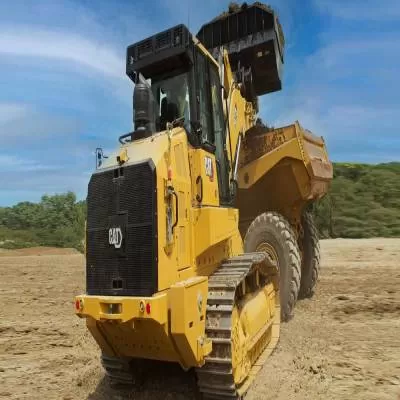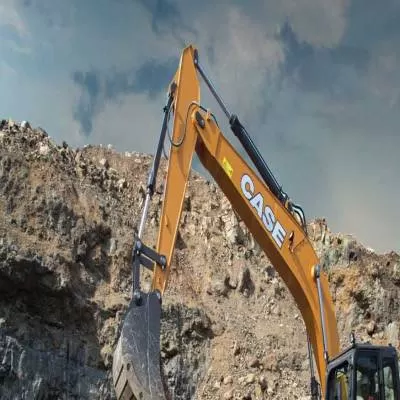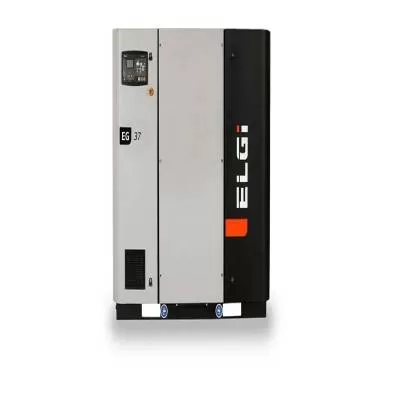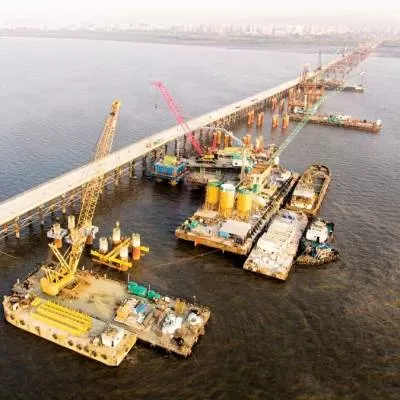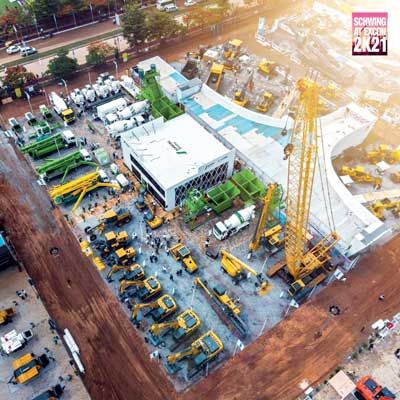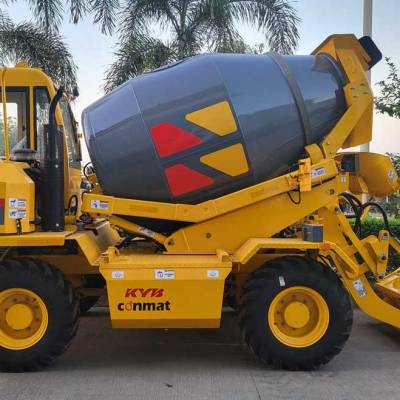Equipment Rental Trends - Rental Realities
How easy or difficult is it to hire construction equipment? What's the deal with the services of equipment providers? Charu Bahri has some answers.
Before the influx of corporate players into the Indian construction industry, it was commonplace for the words ‘unorganised’ and ‘scattered’ to be associated with the sector. What’s more, as long as the parent construction sector was disorganised, providers such as companies offering construction equipment on rent to the industry were also, by and large, geographically scattered small players. It was a classical vicious circle: immature construction and allied rental markets meant that the quality of construction equipment offered was inadequate and insufficient to attract a few big players. Consequently, there was not enough impetus for the rental sector to develop.
Opportunity beckons
Fortunately, however, the entry of national players into the construction industry in recent years has initiated a turnaround. This influx has come as a beacon of opportunity to investors, consumers, and allied sectors, in this case, construction equipment rental providers. The metamorphosis in the way the construction industry works and the lucrative opportunities coming its way have touched the rental sector in no small measure. As Phillipe Clover, President, Quippo Infra-structure Equipment Ltd, points out, “The market is in evolution, driven by a few organised players. There are also an estimated 10,000 unorganised small players.†Rental players such as Gemini Equipment and Rentals Pvt Ltd count the infrastructure boom as a major growth driver in the industry. “Given the ongoing thrust on the development of roads, ports and power infrastructure, the outlook in the medium term for the sector is healthy,†says Rajiv Sethi, Managing Director & CEO, Gemini Equipment and Rentals Pvt Ltd. Further, he has observed that in developed markets, rental penetration hovers between 50 and 80 per cent of the total construction equipment sold in the domain while India lags far behind with a rental penetration of 7 to 8 per cent. Still, Sethi is optimistic and says he expects the industry to grow to the 15-20 per cent mark over the next three years.
Rise of pan-Indian players
Clover believes the entry of organised players into the segment will significantly increase the penetration of rentals in the coming years, and thereby promote the concept of renting equipment. He believes this will bode well for larger players as well as medium-sized contractors, saying, “The focus on infrastructure development is seeing larger players embarking on projects in diverse areas of the country. In such a scenario, contractors will find it easier to work with a pan-Indian rental company that can provide equipment from its nearby branch offices. Timely and easy access to appropriate, well-maintained equipment can kick-start the implementation of projects. We have provided equipment to more than 200 clients at over 250 sites.â€
“It is essential for a rental company to maintain strategically located branch offices to cater to a larger geographical area,†adds Sethi. “We can then move equipment swiftly to a desired area. In our experience, the ability to provide well-maintained equipment and trained operators at short notice has been a major growth vehicle for our company.â€
Developing, not developed markets
But is the emergence of a few national players in the construction equipment rental sector enough? Apparently not; if the words of a few industry leaders are anything to go by, the market has some way to go before it may be counted as fully developed.
Commenting on the present state of the construction equipment rental market, Amitabh Mundhra, Director, Simplex Infrastructures Ltd, notes, “The market is as yet populated by very few national players and, as such, is still to mature. As a result, most construction companies depend on the ownership [vis-à -vis rental] model
of equipment.â€
Reflecting on whether the Indian market is adequately served by construction equipment rental companies, Robert Anthony Allen, President, Plant & Equipment, Punj Lloyd Ltd, shares, “The rental market in India is still in its infancy and is regional rather than national. As such, there are several gaps in the hiring market, vis-à -vis Europe and other developed countries. As far as our experience goes, we have one of the largest and most sophisticated plant fleets in India and therefore do not need to rely on the hire market. However, we would welcome professional hirers for common equipment such as excavators and dump trucks, which would mean we could reduce investment in common equipment and concentrate our investment in specialist equipment.â€
KV Rangaswami, Whole-Time Director & President [Construction], L&T points out that the industry is not at all sufficient in all categories of machineries essential for the industry, although for that matter, even the very big companies in the industry are yet to acquire many strategic machineries with latest technology, leave alone hiring companies. In order to meet international benchmark levels of quality, speed and safety, Indian construction and hiring companies need to upgrade themselves in many spheres of execution. Rangaswami believes this process must happen continuously, nonstop, as the gap is very large from the point of view of international standards and the vast scope of projects in infrastructure building and construction of residential, commercial and industrial complexes needed to be fulfilled in the next six years. Once the present recession breaks even, he expects the demand for good, efficient, well-equipped and resourceful construction and hiring companies with resources, talent, knowledge and skill reserve to be tremendous.
A maturing market
‘Appropriate’ and ‘well maintained’ are the buzzwords of the construction equipment rental sector. A sign of maturity in the rental market is its ability to offer a wide range of equipment incorporating the latest technology, as well as trained operators and service personnel to maintain and troubleshoot its usage. To this end, Sethi shares that Gemini offers a young fleet operated by its own staff as this ensures high machine reliability. Older machines are procured, selectively purchased, and suitably refurbished prior to renting out. With regard to service, he says, “We have trained personnel to routinely service our own equipment. However, as and when required we call upon the OEM’s service personnel. Also, as and when required, we offer third party testing [and certification of usage] by an authorised inspector.â€
“We provide fully trained operators and maintenance services, which includes maintenance personnel as well as quality spare parts to ensure functionality of equipment,†adds Clover. What’s more, speaking of Quippo’s commitment to professionalism and safe working practices, he shares, “Our equipment is covered by a comprehensive insurance policy that minimises risks and exposure for Quippo as well as our customers as long as each party’s responsibilities are met in terms of equipment safety, safe use and protection.â€
Identifying service gaps
According to Vidhu Shekhar, Manager – Purchase, Valecha Engineering Ltd, the services of rental players are by and large satisfactory in terms of the availability of equipment and trained operators. However, certain classes of specialised equipment, such as pneumatic tire rollers for road applications, pavers, soil stabilisation and foundation equipment like vibratory hammers and diaphragm walling kits and attachments used to lay foundations, are sometimes in short supply. Further, he notes that maintenance services need vast improvement. “There is a lack of professionalism in the approach of low-profile players in the market,†he says. “When it comes to maintenance, especially when equipment is rented out over a longer duration of time, these providers not only cut costs but also neglect the equipment and try to make do with their own personnel and cheap replacements of critical spares, which are sometimes unable to offer adequate troubleshooting services, nor sustain in the long run. Company personnel should be brought in as and when required.â€
“The upkeep, maintenance and output of equipment available on rent are of concern,†adds Mundhra. “Maintenance services should include the OEM. If providers focus on short-term maximisation of return, the life of equipment as well as its output is reduced in the long run. Overall, the quality of service needs improvement.â€
Citing the main problems as quality of equipment, skill level of the operator and performance (in that order), Allen also observes that providers need to focus on improving service and reaction time, both of which are a key part of the rental companies’ responsibility to the customer.
“Professionally managed hiring companies, well organised with systems in place — that’s the need of the hour,†says Rangaswami, adding, “Well-maintained, dependable machinery with experienced staff and operators, dependable for the out-turn and productivity; and the conviction of hiring companies to cooperate and collaborate with the construction companies to complete the assigned quantum of works in time with good quality and best standards of safety are needed.â€
The way forward
The industry has spoken. Now, it is up to rental companies to come up with solutions to these issues, and fulfil the expectations of clients. Then, the industry can look forward to sustained growth in demand for its services as the next generation of rental clients enters the arena.
Even from the point of view of a large company, Rangaswami expresses a keen interest in vendor development for services and supply for the needs of its projects. “As we scale up our size to execute huge orders to meet the expectations of our clients, we cannot build up certain project needs overnight,†he explains. “There are practical difficulties such as lead time for delivery of new construction equipment from manufacturers to meet the sudden upsurge and training personnel to operate it. In such situations it would be easier to outsource to meet immediate needs at short notice.†There is a note of optimism as Rangaswami concludes, “All these companies will get built up very quickly as a country like India offers huge opportunities.†It’s just a question of recognising them — and seizing them.
Where is it Available?
Cities served by pan-Indian construction equipment rental companies include Ahmedabad, Bhopal, Bhubaneswar, New Delhi, Bengaluru, Secunderabad, Gurgaon, Mumbai, Raipur, Kolkata, Guwahati, Patna, Chennai.
What's on Offer?
Earthmoving and general construction equipment
• Dozers (150-180 hp)
• Motor graders (135-180 hp)
• Hydraulic excavators (6 t to 50 t)
• Backhoe loaders (0.23 cu m)
• Wheel loaders (1.7 cu m to 3.1 cu m)
• Air compressors (250 to 600 cfm)
• Power generators (62.5 kva to 500 kva)
Soil improvement equipment
• Rotary piling rigs (up to 2,500 mm dia)
Road construction equipment
• Asphalt sensor pavers (4.5 m to 90 m)
• Tandem roller (2.4 t to 9 t)
• Vibratory roller
• Vibratory soil compactor (10 t to 11 t)
• Pneumatic tyre roller (10 t)
• Bitumen sprayer atlas
Concrete equipment
• Concrete pump (45 cu m/hr to 70 cu m/hr)
• Concrete boom placer (70 cu m/hr)
• Concrete mixer (6.0 cu m)
Transport equipment
• Dumper (15 cu m to 20 cu m)
• Transit mixers (6 cu m)
Lifting equipment
• Stationary tower cranes (2,300 kg @ 50 m)
• Mobile tower cranes (800 kg @ 25 m)
• Crawler cranes (20 t to 150 t)
• Rough/all terrain cranes (8 t to 150 t)
• Forklifts, reach stackers, tractors, etc.
Captive power plant
• DG set with acoustic
Access solution products (rack and pinion)
• Passenger hoist Alimak and Wickham
• Goods hoist Wickham
• Work platform HEK
• Scissor lift MEC
Security Deposit
If you’re planning to rent, be prepared to shell out approximately one to two months of the monthly rental of the equipment as security deposit.
How easy or difficult is it to hire construction equipment? What's the deal with the services of equipment providers? Charu Bahri has some answers. Before the influx of corporate players into the Indian construction industry, it was commonplace for the words ‘unorganised’ and ‘scattered’ to be associated with the sector. What’s more, as long as the parent construction sector was disorganised, providers such as companies offering construction equipment on rent to the industry were also, by and large, geographically scattered small players. It was a classical vicious circle: immature construction and allied rental markets meant that the quality of construction equipment offered was inadequate and insufficient to attract a few big players. Consequently, there was not enough impetus for the rental sector to develop. Opportunity beckonsFortunately, however, the entry of national players into the construction industry in recent years has initiated a turnaround. This influx has come as a beacon of opportunity to investors, consumers, and allied sectors, in this case, construction equipment rental providers. The metamorphosis in the way the construction industry works and the lucrative opportunities coming its way have touched the rental sector in no small measure. As Phillipe Clover, President, Quippo Infra-structure Equipment Ltd, points out, “The market is in evolution, driven by a few organised players. There are also an estimated 10,000 unorganised small players.†Rental players such as Gemini Equipment and Rentals Pvt Ltd count the infrastructure boom as a major growth driver in the industry. “Given the ongoing thrust on the development of roads, ports and power infrastructure, the outlook in the medium term for the sector is healthy,†says Rajiv Sethi, Managing Director & CEO, Gemini Equipment and Rentals Pvt Ltd. Further, he has observed that in developed markets, rental penetration hovers between 50 and 80 per cent of the total construction equipment sold in the domain while India lags far behind with a rental penetration of 7 to 8 per cent. Still, Sethi is optimistic and says he expects the industry to grow to the 15-20 per cent mark over the next three years. Rise of pan-Indian playersClover believes the entry of organised players into the segment will significantly increase the penetration of rentals in the coming years, and thereby promote the concept of renting equipment. He believes this will bode well for larger players as well as medium-sized contractors, saying, “The focus on infrastructure development is seeing larger players embarking on projects in diverse areas of the country. In such a scenario, contractors will find it easier to work with a pan-Indian rental company that can provide equipment from its nearby branch offices. Timely and easy access to appropriate, well-maintained equipment can kick-start the implementation of projects. We have provided equipment to more than 200 clients at over 250 sites.†“It is essential for a rental company to maintain strategically located branch offices to cater to a larger geographical area,†adds Sethi. “We can then move equipment swiftly to a desired area. In our experience, the ability to provide well-maintained equipment and trained operators at short notice has been a major growth vehicle for our company.†Developing, not developed marketsBut is the emergence of a few national players in the construction equipment rental sector enough? Apparently not; if the words of a few industry leaders are anything to go by, the market has some way to go before it may be counted as fully developed. Commenting on the present state of the construction equipment rental market, Amitabh Mundhra, Director, Simplex Infrastructures Ltd, notes, “The market is as yet populated by very few national players and, as such, is still to mature. As a result, most construction companies depend on the ownership [vis-à -vis rental] model of equipment.†Reflecting on whether the Indian market is adequately served by construction equipment rental companies, Robert Anthony Allen, President, Plant & Equipment, Punj Lloyd Ltd, shares, “The rental market in India is still in its infancy and is regional rather than national. As such, there are several gaps in the hiring market, vis-à -vis Europe and other developed countries. As far as our experience goes, we have one of the largest and most sophisticated plant fleets in India and therefore do not need to rely on the hire market. However, we would welcome professional hirers for common equipment such as excavators and dump trucks, which would mean we could reduce investment in common equipment and concentrate our investment in specialist equipment.†KV Rangaswami, Whole-Time Director & President [Construction], L&T points out that the industry is not at all sufficient in all categories of machineries essential for the industry, although for that matter, even the very big companies in the industry are yet to acquire many strategic machineries with latest technology, leave alone hiring companies. In order to meet international benchmark levels of quality, speed and safety, Indian construction and hiring companies need to upgrade themselves in many spheres of execution. Rangaswami believes this process must happen continuously, nonstop, as the gap is very large from the point of view of international standards and the vast scope of projects in infrastructure building and construction of residential, commercial and industrial complexes needed to be fulfilled in the next six years. Once the present recession breaks even, he expects the demand for good, efficient, well-equipped and resourceful construction and hiring companies with resources, talent, knowledge and skill reserve to be tremendous. A maturing market ‘Appropriate’ and ‘well maintained’ are the buzzwords of the construction equipment rental sector. A sign of maturity in the rental market is its ability to offer a wide range of equipment incorporating the latest technology, as well as trained operators and service personnel to maintain and troubleshoot its usage. To this end, Sethi shares that Gemini offers a young fleet operated by its own staff as this ensures high machine reliability. Older machines are procured, selectively purchased, and suitably refurbished prior to renting out. With regard to service, he says, “We have trained personnel to routinely service our own equipment. However, as and when required we call upon the OEM’s service personnel. Also, as and when required, we offer third party testing [and certification of usage] by an authorised inspector.†“We provide fully trained operators and maintenance services, which includes maintenance personnel as well as quality spare parts to ensure functionality of equipment,†adds Clover. What’s more, speaking of Quippo’s commitment to professionalism and safe working practices, he shares, “Our equipment is covered by a comprehensive insurance policy that minimises risks and exposure for Quippo as well as our customers as long as each party’s responsibilities are met in terms of equipment safety, safe use and protection.†Identifying service gapsAccording to Vidhu Shekhar, Manager – Purchase, Valecha Engineering Ltd, the services of rental players are by and large satisfactory in terms of the availability of equipment and trained operators. However, certain classes of specialised equipment, such as pneumatic tire rollers for road applications, pavers, soil stabilisation and foundation equipment like vibratory hammers and diaphragm walling kits and attachments used to lay foundations, are sometimes in short supply. Further, he notes that maintenance services need vast improvement. “There is a lack of professionalism in the approach of low-profile players in the market,†he says. “When it comes to maintenance, especially when equipment is rented out over a longer duration of time, these providers not only cut costs but also neglect the equipment and try to make do with their own personnel and cheap replacements of critical spares, which are sometimes unable to offer adequate troubleshooting services, nor sustain in the long run. Company personnel should be brought in as and when required.†“The upkeep, maintenance and output of equipment available on rent are of concern,†adds Mundhra. “Maintenance services should include the OEM. If providers focus on short-term maximisation of return, the life of equipment as well as its output is reduced in the long run. Overall, the quality of service needs improvement.†Citing the main problems as quality of equipment, skill level of the operator and performance (in that order), Allen also observes that providers need to focus on improving service and reaction time, both of which are a key part of the rental companies’ responsibility to the customer. “Professionally managed hiring companies, well organised with systems in place — that’s the need of the hour,†says Rangaswami, adding, “Well-maintained, dependable machinery with experienced staff and operators, dependable for the out-turn and productivity; and the conviction of hiring companies to cooperate and collaborate with the construction companies to complete the assigned quantum of works in time with good quality and best standards of safety are needed.†The way forwardThe industry has spoken. Now, it is up to rental companies to come up with solutions to these issues, and fulfil the expectations of clients. Then, the industry can look forward to sustained growth in demand for its services as the next generation of rental clients enters the arena. Even from the point of view of a large company, Rangaswami expresses a keen interest in vendor development for services and supply for the needs of its projects. “As we scale up our size to execute huge orders to meet the expectations of our clients, we cannot build up certain project needs overnight,†he explains. “There are practical difficulties such as lead time for delivery of new construction equipment from manufacturers to meet the sudden upsurge and training personnel to operate it. In such situations it would be easier to outsource to meet immediate needs at short notice.†There is a note of optimism as Rangaswami concludes, “All these companies will get built up very quickly as a country like India offers huge opportunities.†It’s just a question of recognising them — and seizing them. Where is it Available? Cities served by pan-Indian construction equipment rental companies include Ahmedabad, Bhopal, Bhubaneswar, New Delhi, Bengaluru, Secunderabad, Gurgaon, Mumbai, Raipur, Kolkata, Guwahati, Patna, Chennai. What's on Offer?Earthmoving and general construction equipment• Dozers (150-180 hp)• Motor graders (135-180 hp)• Hydraulic excavators (6 t to 50 t)• Backhoe loaders (0.23 cu m)• Wheel loaders (1.7 cu m to 3.1 cu m)• Air compressors (250 to 600 cfm)• Power generators (62.5 kva to 500 kva) Soil improvement equipment• Rotary piling rigs (up to 2,500 mm dia) Road construction equipment• Asphalt sensor pavers (4.5 m to 90 m)• Tandem roller (2.4 t to 9 t) • Vibratory roller• Vibratory soil compactor (10 t to 11 t)• Pneumatic tyre roller (10 t)• Bitumen sprayer atlas Concrete equipment• Concrete pump (45 cu m/hr to 70 cu m/hr)• Concrete boom placer (70 cu m/hr)• Concrete mixer (6.0 cu m) Transport equipment• Dumper (15 cu m to 20 cu m)• Transit mixers (6 cu m) Lifting equipment• Stationary tower cranes (2,300 kg @ 50 m)• Mobile tower cranes (800 kg @ 25 m)• Crawler cranes (20 t to 150 t)• Rough/all terrain cranes (8 t to 150 t)• Forklifts, reach stackers, tractors, etc. Captive power plant• DG set with acoustic Access solution products (rack and pinion)• Passenger hoist Alimak and Wickham • Goods hoist Wickham • Work platform HEK • Scissor lift MEC Security DepositIf you’re planning to rent, be prepared to shell out approximately one to two months of the monthly rental of the equipment as security deposit.


